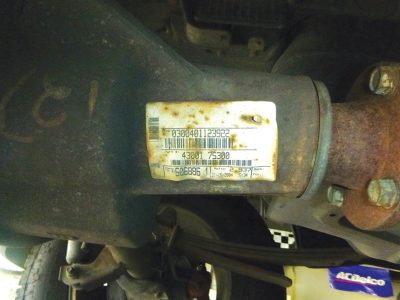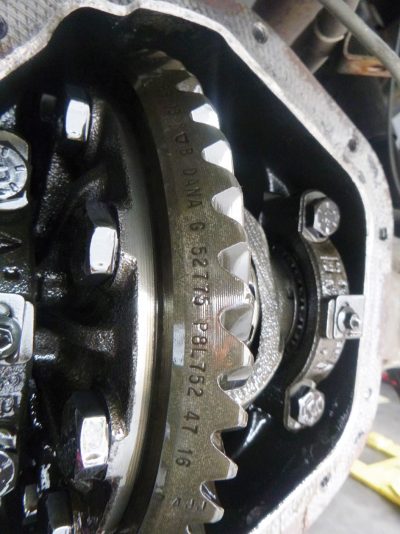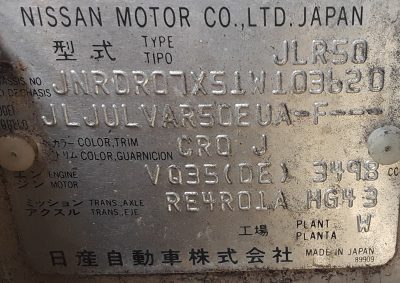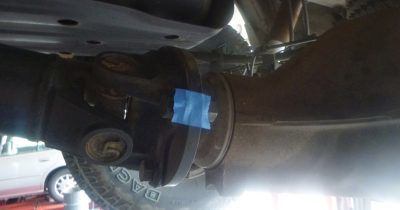With the versatility in light truck drivetrains comes the inevitable variety in drivetrain parts. Both front and rear differentials must have the correct gear sets in them. Let’s take a look at how to identify that axle and identify the parts you need to get the job done right.
It’s an unfortunate situation we find ourselves in, diagnosing a failure inside the differential. What can make that a lot worse is installing the wrong gear set and having to do the job twice.
Different axle ratios were available in many Nissan trucks for a variety of reasons. Trying to get the most power to the ground with the best fuel mileage is the underlying thought. Unfortunately, this is dramatically different depending on what the truck is used for. Aside from aftermarket modifications and DIYers trying to take their trucks to the extreme, stock vehicles will have different gear sets for towing, off roading, economy or performance applications.
When ordering a replacement rear end, front differential, or internal gear parts, it is critical to confirm you are ordering the right part with the correct gear ratio inside. This doesn’t have to be a difficult thing to accomplish. Many axle housings have the original part numbers on a sticker right on the differential housing.

On a 2005 Titan, for example, you’ll find this will be on the right side of the pinion portion of the differential housing. Barring any modifications done previously, this is the first place to look to identify your axle. When you’re talking to the parts department they will identify the type of differential you have without issue. They may not, however, be able to identify the actual gear ratio. All you need is the number representing the gear ratio.
By opening the differential and counting the actual teeth on the gears, simply divide the number of ring gear teeth by the number of pinion gear teeth and round to the nearest gear set available. As an easy example 40 teeth on the ring gear and 20 teeth on the pinion gear is a gear ratio of 2.0:1. Of course, actual gear sets will not be quite that easy number- wise.

Take the example of the 2005 Titan we had earlier. If the sticker was missing, we could simply open the differential and count 47 teeth on the ring gear and 16 on the pinion. Break out the calculator and, poof, 47 divided by 16 is 2.937. That’s the number we need to get the right gear set. Of course, counting teeth is way too difficult. It’s much easier to simply rotate the ring gear until the stamped Dana part numbers are visible and there you have it.
These methods are great if you have a sticker or easy access and time to remove the differential cover. There are still a couple of options if those methods aren’t available. On many vehicles, assuming they’re not modified, you can simply open the driver’s door and read the factory identification sticker found low on the B-pillar. This is a great way to identify all kinds of factory options for the truck you’re working on.


In the bottom left corner of the sticker is the axle identification code. This will be a letter and number combination of 4 digits. The first 2 indicate the differential housing type, and the last 2 indicate the gear ratio. Looking at an Xterra with a code of CA31 we know it has a C200K (8 bolt) axle housing due to the CA and a gear ratio rounded from 3.13:1. This is all the info needed to get the right gear sets. Another example might be HG43. That would be an H233B rear axle housing with, you guessed it, a 4.3:1 gear ratio. If the sticker isn’t available in the door jamb you may find a similar tag on the bulkhead under the hood.
A well-used truck may have long lost any identification stickers and tags. This doesn’t mean we’re completely out of luck. With a bit more math and a jack we can positively identify that axle ratio and get the right gear set. First, we need to know if the truck has a limited slip differential. With both wheels off the ground, rotate one tire. Does the other turn the same direction or the opposite direction? If it turns the opposite direction perform the test with one wheel on the ground and multiply your final answer by 2. If it spins the same direction both wheels will have to be off the ground.
Next, mark the tire and driveline to identify a set point in the rotation. Then, with the front wheels chocked and transmission in Neutral, rotate the wheel and count the revolutions of both the tire and the driveline. If you’re really good at identifying percentages of a circle your axle ratio is the number of times the driveline rotates when the tire makes one full rotation. For the rest of us rotate the tire 4 or 5 times and divide the number of driveline rotations by 4 or 5 respectively to get your answer. Remember, if you have an open differential and one wheel on the ground you will have to multiply your final answer by 2.

The more options for gear sets that are available for your application, the more precise you will have to be. Let’s look at some numbers to make it make sense. On a truck with an open differential, you rotate the tire 4 times and count about 7 revolutions of the driveshaft. Divide 7 by 4 and you get 1.75. Multiply that by 2, due to the open differential, and you come up with 3.5. If your gear ratio options are 2.97, 3.56, or 4.625 you can assume it’s 3.56.
One final thought to consider is that a lot of the time simply looking up the part or calling your Nissan parts department will be all you need to do to get the right gear set. There are frequently external indicators as to what equipment the vehicle came with from the factory.
A great example is if the truck came with a factory mounted trailer tow hitch receiver. It tends to be easily identified by the perfect fit, proper wire routing for the trailer lights and the complete lack of any stickers that identify it as an aftermarket part. Trucks with a factory towing package will have a shorter gear ratio (higher number) to provide more torque to the ground and increase the towing capacity.
If the part selection is in question, be thorough and make sure you match up the old with the new before installing it. If you suspect modifications have been done, it’s important to make sure your front and rear differentials are a match. Any discrepancy between front and rear gear ratios will make the 4-wheel drive function impossible. With the availability of aftermarket parts and the ever-present backyard mechanic, it’s not the best idea to assume you have the correct gears because of external markings or tags, but rather trust and then verify.






0 Comments